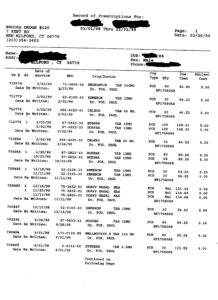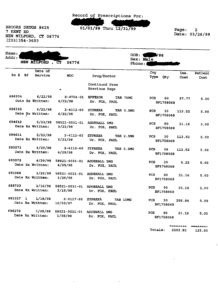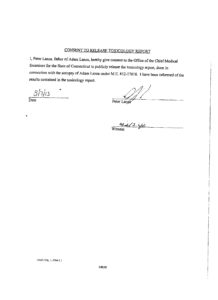Lanza’s Medical Records Too Many Unanswered Questions
The Hartford Courant reported today that the father of the Sandy Hook shooter, Adam Lanza, is willing to release his son’s medical records to the Commission tasked with making possible changes to the State’s mental health services.
While Ablechild applauds Peter Lanza’s willingness to assist the State, the offer, and reporting of it by The Courant, raises important questions. It also, unfortunately, reveals big, Grand Canyon size, holes in the official investigations.
As is well known, Ablechild spent the last year mired in State stall tactics in response to the organization’s request for Adam Lanza’s medical/mental health/toxicology records, which are key to understanding the motive for the tragic assault at Sandy Hook, and also whether any changes need to be made to the State’s mental health services.
The result of Ablechild’s exhaustive efforts was the State’s Assistant Attorney General, Patrick B. Kwanashie, explaining that the reason for withholding Lanza’s medical records was because it “would cause a lot of people to stop taking their medications.“
Really, which “medications?” Clearly, the State has information, and great concerns, about medications Lanza had been taking. Why else would the Assistant Attorney General make such an astonishing statement?
Ablechild publicly released this information, as did other news organizations. However, despite what can be called extensive coverage of the Sandy Hook shooting incident and its aftermath by The Courant, the news organization apparently did not find the information important enough to report it to its readers, let alone do any follow-up.
This is odd given The Courant’s inside knowledge of Lanza’s medical records. In June of 2013, six months after the shooting incident at Sandy Hook, (about the same time Ablechild began making official requests for Lanza’s records) The Courant ran a piece title, Adam Lanza’s Medical Records Reveal Growing Anxiety.
According to the article, “The Courant obtained exclusive information from medical and school records that have for months been kept secret by agencies investigating the shootings. The documents span Lanza’s life from birth to age 18, including a September 2005 medical summary of the Danbury Hospital emergency room visit.”
The Courant’s admission of having inside information about Lanza’s medical records is extremely important now that both the State’s Attorney General and State Police have issued their respective reports on the shooting incident.
Most important is the fact that neither of the official reports mention Lanza’s 2005 Danbury Hospital emergency room visit, leaving one to question why this particular information would be left out of official investigative reports, especially in light of the fact that The Courant already had made it public.
In fact, no medical/mental health information about Lanza is provided in either report after 2007, when Adam would have been fifteen years old. The last acknowledged mental health treatment was provided by the Yale Child Studies Center when Adam was fifteen years old, abruptly ending in February of 2007. Apparently, Nancy Lanza had reported to Kathleen Koenig that there had been an adverse reaction to the psychiatric drug, Celexa, Adam had been prescribed by the Yale Center.
Neither of the investigative reports mention any mental health treatment after this Yale incident for the five years leading up to the shooting.
Having announced that the newspaper was in possession of Lanza’s medical records until the age of 18, the question, then, is what additional information does The Courant have regarding Lanza’s medical/mental health treatment? The Courant reports to having three years of information beyond what has been made available by the official investigations.
Furthermore, according to the same article in The Courant, it “obtained exclusive information from medical and school records that have for months been kept secret by agencies investigating the shootings.” The Courant appears to be reporting that the investigative agencies were in possession of this “secret” medical information but, apparently, failed to make it part of either investigation? Why?
Beyond what, if any, additional information The Courant may be able to provide about Lanza’s mental health treatment, one also has to wonder why the Commission is left begging the father of the shooter for information that should have been made public as part of the investigation.
Certainly, one would expect that, in order to form a legitimate, informed, opinion about what may have been the motive for the attack, both of the official investigations would have requested and then were provided all of Lanza’s medical/mental health records. One might assume this information is the “secret” records that The Courant reported.
And, in fact, both of the investigative reports reveal that medical/mental health records were obtained from the Lanza home and also from Peter Lanza directly after the incident.
Why, then, is this State sponsored Commission getting the run-around? Either both official investigative teams asked for, and received, all of Lanza’s medical/mental health records, or they didn’t. Has the Commission even asked this question? Has The Courant asked the question?
Additionally, Ablechild spent three full days reviewing every single sheet of paper made available in the State Police Report. Yes, it was frustrating. Due to the extensive duplication of documents and heavy redactions, the report provided little in the way of answers, but nothing so difficult as to require the assistance of a law firm.
More to the point, the law firm that apparently is tasked with making sense of the documents for the Commission, very likely could have a major conflict of interest. According to the attorney for the Commission, Daniel J. Klau, his law firm, McElroy, Deutsch, Mulvaney & Carpenter, is working on the documents.
Klau’s law firm represents no less than 19 pharmaceutical companies, including Merck, Novartis, Abbott and Johnson & Johnson. For the sake of argument, let’s assume the Commission obtains all of Lanza’s medical/mental health records and they reveal that Lanza had been prescribed one or several drugs, including a drug produced by one of the pharmaceutical companies Klau and his law firm represent. That clearly would be a conflict of interest. Will Klau (and his law firm) recuse himself?
In fact, because State’s Assistant Attorney General, Patrick B. Kwanashie has made it abundantly clear that “medications” are involved in this case, it would seem logical to request that the entire Commission disclose all personal and professional ties to the pharmaceutical industry and, if appropriate, remove themselves from the Commission.
Frankly, an investigation that provides no medical/mental health information about the last five years of the shooter’s life is embarrassing.
The fact that Lanza’s primary psychiatrist, Dr. Fox, destroyed his records and fled the country is, at best, suspicious.
That the official investigative reports did not make public Lanza’s medical/mental health records is a scandal.
The fact that the State created Commission, tasked with making recommendations about the future of State mental health services, is left relying on the shooter’s father for medical/mental health data, is also a scandal.
It is time for full disclosure in every aspect of this case and Adam Lanza’s medical/mental health/full toxicology reports must be made public.
The victims, their families, and the people of Connecticut deserve all the truth.




